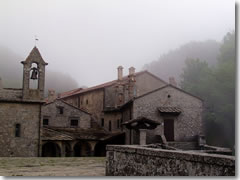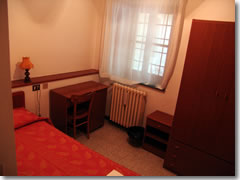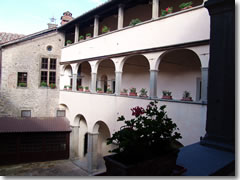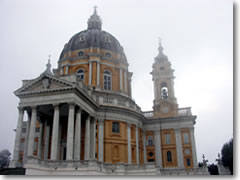- Places
- Plans
- Itineraries
- Experiences
 x
x

Suddenly, a heavenly seraphim appeared and bestowed upon him the holiest of all saintly afflictions: the stigmata, miraculous wounds replicating those suffered by Christ on the Cross.
This scene, which sealed Francis's saintliness, has been reproduced in countless frescoes and altarpieces across Tuscany. The story has drawn pilgrims and tourists, the faithful and the merely curious, to the Santuario della Verna monastery that sprang up around the miraculous cave between the 13th and 15th centuries.
La Verna remains a place out of time, a cluster of medieval stone buildings perched atop a forbidding cliff often shrouded in morning mist. Time is measured by the silent processions of white-robed monks.
They make their way silently though the stone streets, on their way to sing the calls to hours (guests are welcome to attend) in a main church and a dozen chapels decorated with blue-and-white glazed terracotta sculptures by the famous Renaissance della Robbia clan. Visitors—of any faith, or none—are welcome to stay in the Foresteria.
The 72 guest rooms along arcaded cloisters and adjacent halls are as austere as you'd expect—tiny chambers with formica floors, aging modular furnishing units, and a crucifix on the wall—but each is heated and comes with a tiny private bathroom.
You might dine with a young Italian Catholic staying for devotional purposes, a transcendental spiritualist who came for the meditative atmosphere, an American protestant fascinated by pilgrimage sites, and an avowed atheist curious about the anthropological side of people who stay in monasteries.
Conversations tend to be wide-ranging, and frequently turn to religion, but the gentle spirit of St. Francis seems to prevail above polemics. Visitors usually seem intent on sharing thoughts on faith and discussing the differences between their firmly held beliefs without condemnation or attempts at conversion, merely a desire to understand other points of view—and to get a glimpse into the ancient monastic lifestyle recounted in countless medieval frescoes wallpapering Italian churches.
 The wildly rococo Basilica di Superga, designed by Filippo Juvarra and a scenic cog railway ride above the city of Torino in Italy's Piemonte region, is run by the Servi di Maria (Servants of Maria) lay order, and has a hostelry which will put up guests for €25 a person ((+39-011-899-7456, www.basilicadisuperga.com)(Also all Italian)) Monks live in simple cells, and you should expect the same: modular furnishings, narrow beds, and a decorative scheme heavy on Jesus and the Virgin Mary.
The wildly rococo Basilica di Superga, designed by Filippo Juvarra and a scenic cog railway ride above the city of Torino in Italy's Piemonte region, is run by the Servi di Maria (Servants of Maria) lay order, and has a hostelry which will put up guests for €25 a person ((+39-011-899-7456, www.basilicadisuperga.com)(Also all Italian)) Monks live in simple cells, and you should expect the same: modular furnishings, narrow beds, and a decorative scheme heavy on Jesus and the Virgin Mary.
You sometimes have to share a bath down the hall—but also often get to share home-style meals, either with fellow travelers or with the monks themselves.
Accommodations may be in a special wing of the monastery complex set aside for visitors, or in a dorm-like room of bunks, or even an unused monk's cell.
Though pilgrims predominate, guests of all faiths (or none) are welcome. You are usually invited, though not required, to attend services and the calls to hours in the chapel.
There are plenty of rules: respect the monks, be fairly quiet, arrive for meals promptly, check in and out at the appointed times, and be back in your room (or at least in the guest wing) by curfew, which may be as early as 9:30pm.
In exchange for all this, you get a cultural exchange program at bargain-basement prices. Regardless of your own religious persuasion, this is an unparalleled opportunity to sample a bit of the monastic life and experience the quiet, reflective solitude of strolling the cloisters and gardens.
If nothing else, a monastery stay can be a welcome break from the hurly-burly of touring endless museums and cathedrals.
Though most religious hospices charge a modest fee of €20 to €60 per person (but note that that fee usually includes at least two meals, breakfast and dinner, and often lunch as well), many monasteries will take in travelers absolutely free of charge.
This is because several monastic orders take "hospitality" as one of their rules, along with their vows of poverty and charity and the like.
Monasteries are rarely found in the big cities—unlike their sister pilgrim lodgings, convents, which are often in towns (especially Rome and Assisi). They tend to be tend to be isolated out in the countryside, in mountainous or rural areas more suited to a monk's life of contemplation.
This can add to the triple benefit: a cheap (or free place to sleep, a unique cultural experience, and a chance to get off the tourist treadmill of Europe's major capitals and into the woods or small town to which the monks have retreated.
Ask local tourism offices; do lots of Googling.
There are several guidebooks to religious lodgings these days, including:
There are also several good online resources:
| English (Inglese) | Italian (Italiano) | Pro-nun-cee-YAY-shun |
| Good day | Buon giorno | bwohn JOUR-noh |
| Good evening | Buona sera | BWOH-nah SAIR-rah |
| Good night | Buona notte | BWOH-nah NOTE-tay |
| Goodbye | Arrivederci | ah-ree-vah-DAIR-chee |
| Excuse me (to get attention) | Scusi | SKOO-zee |
| thank you | grazie | GRAT-tzee-yay |
| please | per favore | pair fa-VOHR-ray |
| yes | si | see |
| no | no | no |
| Do you speak English? | Parla Inglese? | PAR-la een-GLAY-zay |
| I don't understand | Non capisco | non ka-PEESK-koh |
| I'm sorry | Mi dispiace | mee dees-pee-YAT-chay |
| Where is? | Dov'é | doh-VAY |
| ...a hotel | un albergo | oon al-BEAR-go |
| ...a B&B | un bed-and-breakfast | oon bet hand BREK-fust |
| ...a rental room | un'affittacamera | oon ah-feet-ah-CAH-mair-ra |
| ...an apartment for rent | un appartamento | oon ah-part-tah-MENT-toh |
| ...a farm stay | un agriturismo | oon ah-gree-tour-EES-moh |
| ...a hostel | un ostello | oon oh-STEHL-loh |
| How much is...? | Quanto costa? | KWAN-toh COST-ah |
| a single room | una singola | OO-nah SEEN-go-la |
| double room for single use [will often be offered if singles are unavailable] | doppia uso singola | DOPE-pee-ya OO-so SEEN-go-la |
| a double room with two beds | una doppia con due letti | OO-nah DOPE-pee-ya cone DOO-way LET-tee |
| a double room with one big bed | una matrimoniale | OO-nah mat-tree-moan-nee-YAAL-lay |
| triple room | una tripla | OO-nah TREE-plah |
| with private bathroom | con bagno | cone BAHN-yoh |
| without private bathroom | senza bagno [they might say con bagno in comune—"with a communal bath"] | SEN-zah BAHN-yoh |
| for one night | per una notte | pair OO-nah NOH-tay |
| for two nights | per due notti | pair DOO-way NOH-tee |
| for three nights | per tre notti | pair tray NOH-tee |
| Is breakfast included? | É incluso la prima colazione? | ay in-CLOO-soh lah PREE-mah coal-laht-zee-YOAN-nay |
| Is there WiFi? | C'é WiFi? | chay WHY-fy? |
| May I see the room? | Posso vedere la camera? | POH-soh veh-DAIR-eh lah CAH-mair-rah |
| That's too much | É troppo | ay TROH-po |
| Is there a cheaper one? | C'é una più economica? | chay OO-nah pew eh-ko-NO-mee-kah |
Share this page
Search ReidsItaly.com